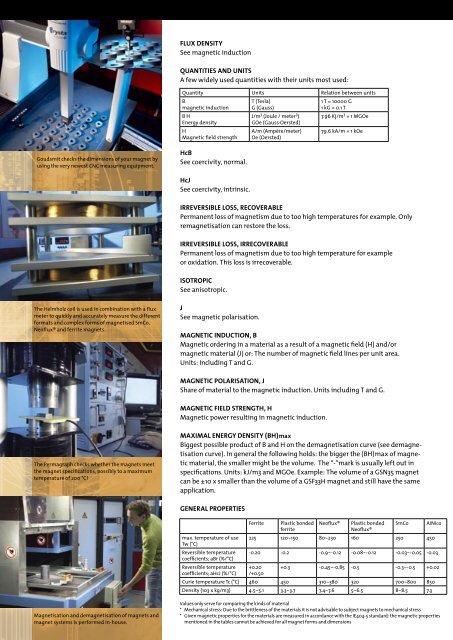permanent magnets
Create successful ePaper yourself
Turn your PDF publications into a flip-book with our unique Google optimized e-Paper software.
Goudsmit checks the dimensions of your magnet by<br />
using the very newest CNC measuring equipment.<br />
The Helmholz coil is used in combination with a flux<br />
meter to quickly and accurately measure the different<br />
formats and complex forms of magnetised SmCo,<br />
Neoflux® and ferrite <strong>magnets</strong>.<br />
The Permagraph checks whether the <strong>magnets</strong> meet<br />
the magnet specifications, possibly to a maximum<br />
temperature of 200 °C!<br />
Magnetisation and demagnetisation of <strong>magnets</strong> and<br />
magnet systems is performed in-house.<br />
FLUX DENSITY<br />
See magnetic induction<br />
QUANTITIES AND UNITS<br />
A few widely used quantities with their units most used:<br />
Quantity Units Relation between units<br />
B<br />
magnetic induction<br />
B H<br />
Energy density<br />
H<br />
Magnetic field strength<br />
HcB<br />
See coercivity, normal.<br />
HcJ<br />
See coercivity, intrinsic.<br />
IRREVERSIBLE LOSS, RECOVERABLE<br />
Permanent loss of magnetism due to too high temperatures for example. Only<br />
remagnetisation can restore the loss.<br />
IRREVERSIBLE LOSS, IRRECOVERABLE<br />
Permanent loss of magnetism due to too high temperature for example<br />
or oxidation. This loss is irrecoverable.<br />
ISOTROPIC<br />
See anisotropic.<br />
J<br />
See magnetic polarisation.<br />
MAGNETIC INDUCTION, B<br />
Magnetic ordering in a material as a result of a magnetic field (H) and/or<br />
magnetic material (J) or: The number of magnetic field lines per unit area.<br />
Units: Including T and G.<br />
MAGNETIC POLARISATION, J<br />
Share of material to the magnetic induction. Units including T and G.<br />
MAGNETIC FIELD STRENGTH, H<br />
Magnetic power resulting in magnetic induction.<br />
MAXIMAL ENERGY DENSITY (BH)max<br />
Biggest possible product of B and H on the demagnetisation curve (see demagnetisation<br />
curve). In general the following holds: the bigger the (BH)max of magnetic<br />
material, the smaller might be the volume. The “-”mark is usually left out in<br />
specifications. Units: kJ/m3 and MGOe. Example: The volume of a GSN35 magnet<br />
can be ±10 x smaller than the volume of a GSF33H magnet and still have the same<br />
application.<br />
GENERAL PROPERTIES<br />
max. temperature of use<br />
Tw (°C)<br />
Reversible temperature<br />
coefficients; aBr (%/°C)<br />
Reversible temperature<br />
coefficients; aHcJ (%/°C)<br />
T (Tesla)<br />
G (Gauss)<br />
J/m 3 (Joule / meter 3 )<br />
GOe (Gauss·Oersted)<br />
A/m (Ampère/meter)<br />
Oe (Oersted)<br />
Ferrite Plastic bonded<br />
ferrite<br />
1 T = 10000 G<br />
1 kG = 0.1 T<br />
7.96 Kj/m 3 = 1 MGOe<br />
79.6 kA/m = 1 kOe<br />
Neoflux® Plastic bonded<br />
Neoflux®<br />
SmCo AINico<br />
225 120~150 80~230 160 250 450<br />
-0.20 -0.2 -0.9~-0.12 -0.08~-0.12 -0.03~-0.05 -0.03<br />
+0.20<br />
/+0.50<br />
+0.3 -0.45~-0.85 -0.5 -0.3~-0.5 +0.02<br />
Curie temperature Tc (°C) 460 450 310~380 320 700~800 850<br />
Density (103 x kg/m3) 4.5~5.1 3.3~3.7 7.4~7.6 5~6.5 8~8.5 7.3<br />
Values only serve for comparing the kinds of material<br />
* Mechanical stress: Due to the brittleness of the materials it is not advisable to subject <strong>magnets</strong> to mechanical stress<br />
* Given magnetic properties for the materials are measured in accordance with the IE404-5 standard: the magnetic properties<br />
mentioned in the tables cannot be achieved for all magnet forms and dimensions


